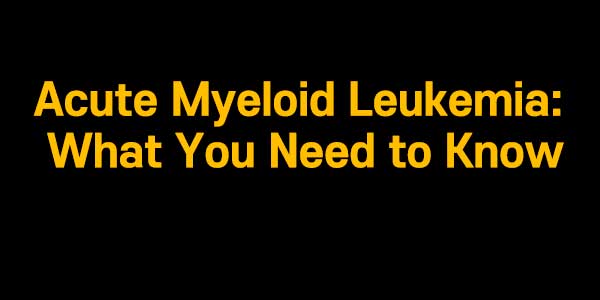
Acute Myeloid Leukemia: What You Need to Know ❤️
Have you ever heard of Acute Myeloid Leukemia and wondered what it really means? 😢 It's more common — and more serious — than you might think. Let’s break it down together.
Hey wonderful friends 👋 Today, I want to talk about something close to my heart. A dear friend of mine recently faced the shock of being diagnosed with Acute Myeloid Leukemia (AML). The journey has been filled with ups and downs, hospital visits, treatments, and a lot of emotional moments.💔 That's why I decided to dive deep and share all the essential information you might need — from symptoms to prevention tips! Stick around — knowledge is power.✨
What is Acute Myeloid Leukemia? 🤔
Acute Myeloid Leukemia (AML) is a type of cancer that starts inside the bone marrow — the soft tissue inside bones that helps form blood cells. It leads to the rapid growth of abnormal white blood cells that accumulate in the bone marrow and interfere with the production of normal blood cells. Unlike some slow-growing cancers, AML is aggressive and needs immediate treatment once diagnosed. 🚑
Causes and Risk Factors ⚡
While the exact cause of AML remains unknown, several factors may increase your risk:
| Risk Factor | Details |
|---|---|
| Genetic Disorders | Conditions like Down syndrome increase AML risk. |
| Exposure to Chemicals | Long-term exposure to benzene or radiation is linked to AML. |
| Prior Cancer Treatments | Chemotherapy or radiation therapy can elevate AML risk. |
Symptoms You Shouldn't Ignore 🚨
Signs and symptoms of AML may mimic other illnesses, which makes early diagnosis tricky. Watch for:
- Persistent fatigue and weakness 😴
- Fever and frequent infections 🤒
- Unexplained weight loss ⚖️
- Easy bruising and bleeding 🩸
- Shortness of breath 🫁
Available Treatments and Therapies 💉
AML treatment usually involves multiple phases:
- Induction therapy — initial high-dose chemotherapy to kill leukemia cells.
- Consolidation therapy — additional treatment to destroy remaining leukemia cells.
- Stem cell transplant — replaces diseased marrow with healthy donor marrow.
Recommended & Avoid Foods 🍎🚫
| Recommended Foods | Foods to Avoid |
|---|---|
| Fresh fruits (washed) | Raw or undercooked meats |
| Steamed vegetables | Unpasteurized dairy products |
| Whole grains | Processed junk foods |
Proactive Tips to Support Recovery ✨
- Stay hydrated and eat a balanced diet. 💧🥗
- Follow medication schedules strictly. ⏰
- Rest as much as needed — your body is healing! 🛌
- Join a support group to connect emotionally. 🤝
FAQ About Acute Myeloid Leukemia ❓
- What is the survival rate for AML?
The five-year survival rate varies but is around 25-30% depending on age and treatment success. - Can AML come back after treatment?
Unfortunately, yes. That’s why regular follow-up checkups are crucial. - Is AML genetic?
Some cases are linked to inherited genetic mutations, but most are acquired mutations. - Are there early warning signs?
Symptoms often appear suddenly and worsen rapidly — don't ignore persistent fatigue or bruising. - Can lifestyle changes prevent AML?
There's no guaranteed prevention, but avoiding toxins and smoking may help reduce risks. - What's the difference between AML and ALL?
AML affects myeloid cells; ALL affects lymphoid cells — both are types of leukemia but differ in behavior and treatment.
Thank you for walking through this emotional and important topic with me. 💛 Whether you or someone you know is going through this, remember: you're not alone. There's a strong community here ready to support you. If you have any questions or personal stories, I'd love to hear them in the comments! Let's lift each other up. 🌟
Acute Myeloid Leukemia, AML, Leukemia Symptoms, Leukemia Causes, Leukemia Treatment, Blood Cancer, Chemotherapy, Bone Marrow Transplant, Healthy Eating Cancer, Cancer Support